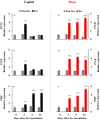Interactive Regulation of Hormone and Resistance Gene in Proline Metabolism Is Involved in Effector-Triggered Immunity or Disease Susceptibility in the Xanthomonas campestris pv. campestris- Brassica napus Pathosystem
- PMID: 35082802
- PMCID: PMC8784845
- DOI: 10.3389/fpls.2021.738608
Interactive Regulation of Hormone and Resistance Gene in Proline Metabolism Is Involved in Effector-Triggered Immunity or Disease Susceptibility in the Xanthomonas campestris pv. campestris- Brassica napus Pathosystem
Abstract
To characterize cultivar variations in hormonal regulation of the transition between pattern-triggered immunity (PTI) and effector-triggered immunity or susceptibility (ETI or ETS), the responses of resistance (R-) genes, hydrogen peroxide, and proline metabolism in two Brassica napus cultivars to contrasting disease susceptibility (resistant cv. Capitol vs. susceptible cv. Mosa) were interpreted as being linked to those of endogenous hormonal levels and signaling genes based on a time course of disease symptom development. Disease symptoms caused by the Xanthomonas campestris pv. campestris (Xcc) infections were much more developed in cv. Mosa than in cv. Capitol, as shown by an earlier appearance (at 3 days postinoculation [3 DPI]) and larger V-shaped necrosis lesions (at 9-15 DPI) in cv. Mosa. The cultivar variations in the R-genes, hormone status, and proline metabolism were found in two different phases (early [0-3 DPI] and later [9-15 DPI]). In the early phase, Xcc significantly upregulated PTI-related cytoplasmic kinase (Botrytis-induced kinase-1 [BIK1]) expression (+6.3-fold) with salicylic acid (SA) accumulation in cv. Capitol, while relatively less (+2.6-fold) with highly increased jasmonic acid (JA) level in cv. Mosa. The Xcc-responsive proline accumulation in both cultivars was similar to upregulated expression of proline synthesis-related genes (P5CS2 and P5CR). During the later phase in cv. Capitol, Xcc-responsive upregulation of ZAR1 (a coiled-coil-nucleotide binding site-leucine-rich repeat [CC-NB-LRR-type R-gene]) was concomitant with a gradual increase in JA levels without additional proline accumulation. However, in cv. Mosa, upregulation of TAO1 (a toll/interleukin-1 receptor-nucleotide binding site-leucine-rich repeat [TIR-NB-LRR-type R-gene]) was consistent with an increase in SA and abscisic acid (ABA) levels and resulted in an antagonistic depression of JA, which led to a proline accumulation. These results indicate that Xcc-induced BIK1- and ZAR1-mediated JA signaling interactions provide resistance and confirm ETI, whereas BIK1- and TAO1-enhanced SA- and/or ABA-mediated proline accumulation is associated with disease susceptibility (ETS).
Keywords: Xanthomonas campestris pv. campestris; effector-triggered immunity; pattern-triggered immunity; phytohormone; proline metabolism; resistance gene.
Copyright © 2022 Mamun, Islam, Lee, Bae and Kim.
Conflict of interest statement
The authors declare that the research was conducted in the absence of any commercial or financial relationships that could be construed as a potential conflict of interest.
Figures







Similar articles
-
Genotypic Variation in Resistance Gene-Mediated Calcium Signaling and Hormonal Signaling Involved in Effector-Triggered Immunity or Disease Susceptibility in the Xanthomonas campestris pv. Campestris-Brassica napus Pathosystem.Plants (Basel). 2020 Mar 1;9(3):303. doi: 10.3390/plants9030303. Plants (Basel). 2020. PMID: 32121557 Free PMC article.
-
Interactive regulation of immune-related resistance genes with salicylic acid and jasmonic acid signaling in systemic acquired resistance in the Xanthomonas-Brassica pathosystem.J Plant Physiol. 2024 Nov;302:154323. doi: 10.1016/j.jplph.2024.154323. Epub 2024 Aug 2. J Plant Physiol. 2024. PMID: 39106735
-
Cultivar Variation in Hormonal Balance Is a Significant Determinant of Disease Susceptibility to Xanthomonas campestris pv. campestris in Brassica napus.Front Plant Sci. 2017 Dec 12;8:2121. doi: 10.3389/fpls.2017.02121. eCollection 2017. Front Plant Sci. 2017. PMID: 29312385 Free PMC article.
-
Label-Free Quantitative Proteomics Analysis in Susceptible and Resistant Brassica napus Cultivars Infected with Xanthomonas campestris pv. campestris.Microorganisms. 2021 Jan 27;9(2):253. doi: 10.3390/microorganisms9020253. Microorganisms. 2021. PMID: 33513868 Free PMC article.
-
Advances in Multi-Omics Approaches for Molecular Breeding of Black Rot Resistance in Brassica oleracea L.Front Plant Sci. 2021 Dec 6;12:742553. doi: 10.3389/fpls.2021.742553. eCollection 2021. Front Plant Sci. 2021. PMID: 34938304 Free PMC article. Review.
Cited by
-
Intra species dissection of phytophthora capsici resistance in black pepper.J Adv Res. 2025 Aug;74:121-136. doi: 10.1016/j.jare.2024.10.015. Epub 2024 Oct 21. J Adv Res. 2025. PMID: 39442874 Free PMC article.
-
The response of rhubarb to smut infection is revealed through a comparative transcriptome and metabolome study.Planta. 2023 Dec 19;259(1):27. doi: 10.1007/s00425-023-04306-w. Planta. 2023. PMID: 38112830
References
-
- Anderson J. P., Badruzsaufari E., Schenk P. M., Manners J. M., Desmond O. J., Ehlert C., et al. . (2004). Antagonistic interaction between abscisic acid and jasmonate-ethylene signaling pathways modulates defense gene expression and disease resistance in arabidopsis. Plant Cell. 16, 3460–3479. 10.1105/tpc.104.025833 - DOI - PMC - PubMed
-
- Ayoubi N., Soleimani M. J. (2014). Possible effects of pathogen inoculation and salicylic acid pre-treatment on the biochemical changes and proline accumulation in green bean. Arch. Phytopathol. Pflanzenschutz. 48, 212–222. 10.1080/03235408.2014.884826 - DOI
LinkOut - more resources
Full Text Sources

